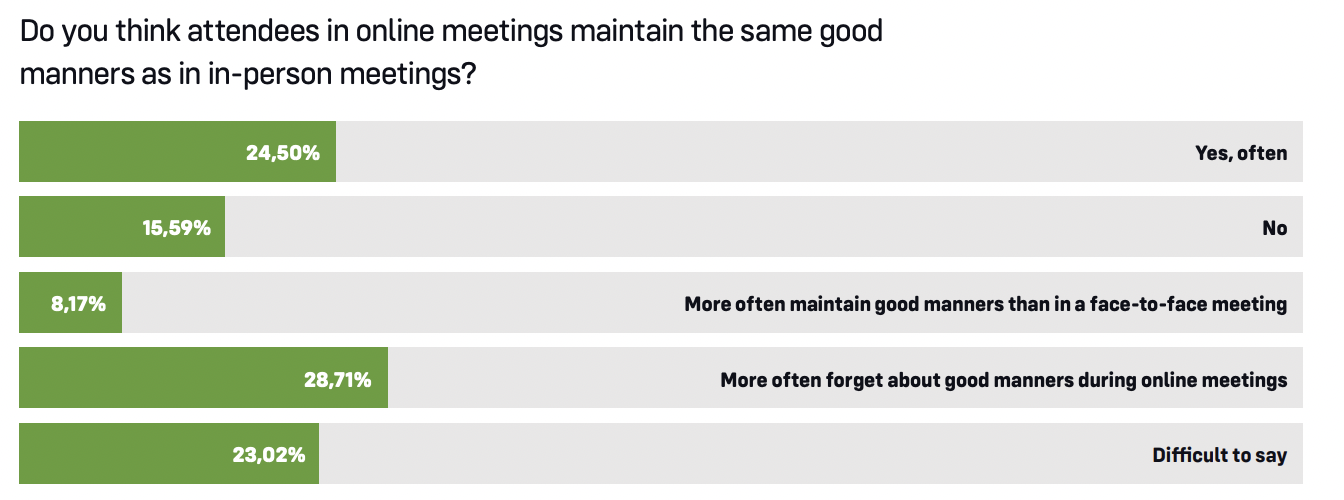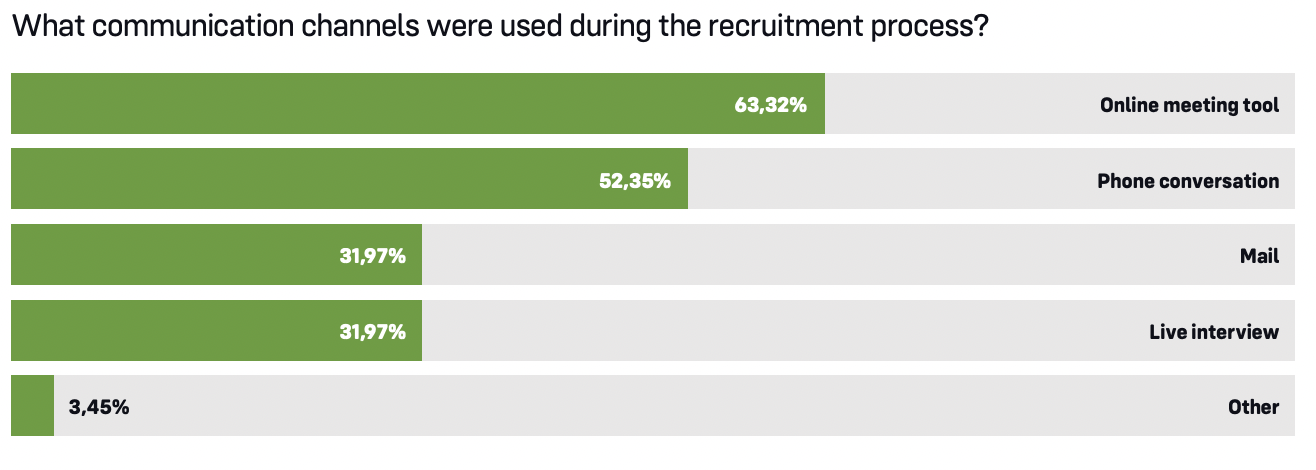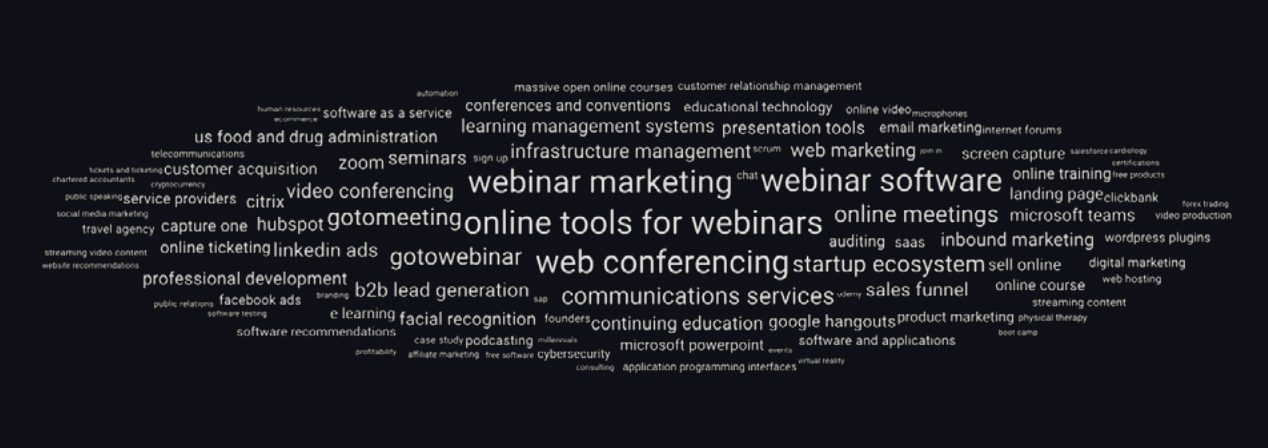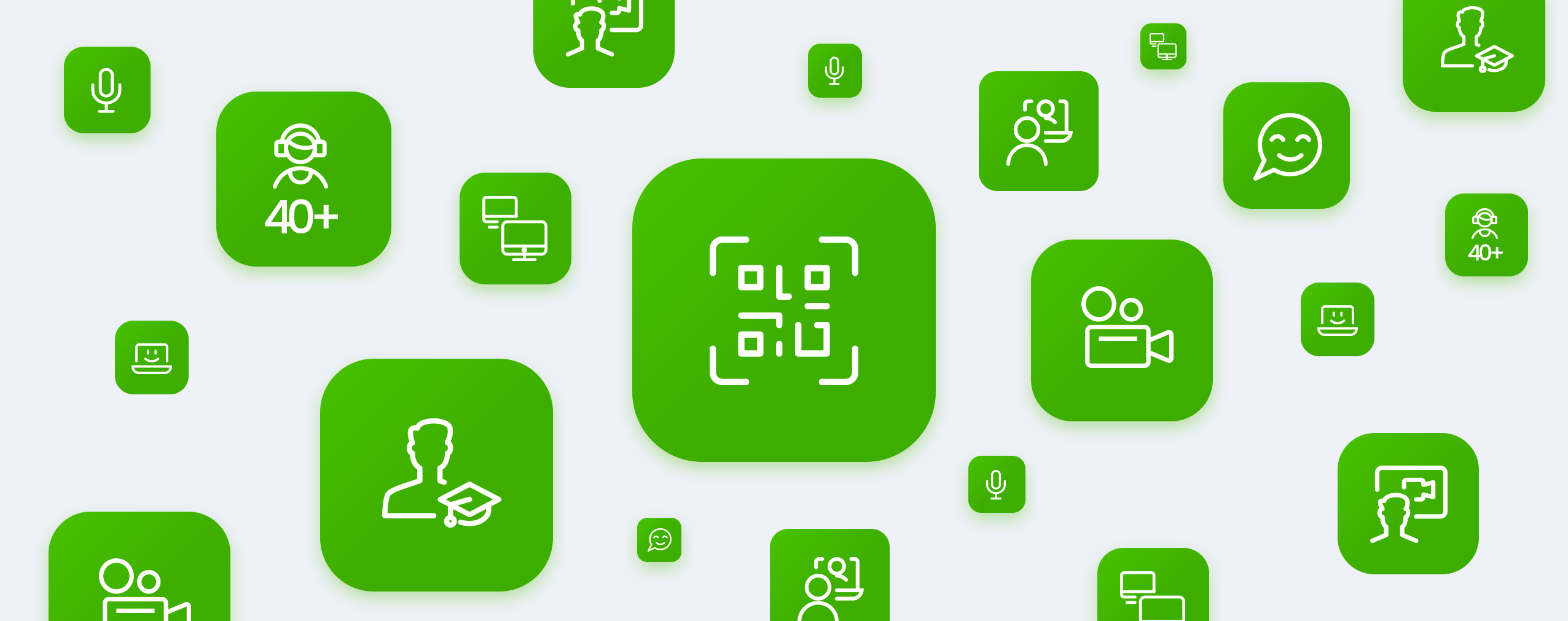The year 2021 is behind us. After the digital transformation we experienced due to the 2020 pandemic, interest in webinars and video conferencing has remained very high. How were these two periods similar, and what was different? What was attendee engagement like and what did they expect? How did the face of the market change?
Download full report
Take a look at the State of Online Events report! Below, you’ll also discover key findings from our analysis of the nearly 2 million online events that took place on the ClickMeeting platform in 2021, and the results of our research.
Table of Contents
Key findings
In 2021, the ClickMeeting platform hosted 1,953,406 events with 26,603,480 attendees. This gives an average of 39,393 events per week!
On average, a webinar lasted 98 minutes, and an online meeting lasted for 66 minutes. This is an increase of as much as 20% over the previous year!
Most events were held on Tuesday, with Wednesday and Thursday coming next. Organizers’ favorite hours were 3 p.m. and 4 p.m.
The most used feature of the ClickMeeting platform was the presentation – It was used 55.12% of the time. Screen sharing was the second most used feature (17.01%), followed by the interactive whiteboard (5.98%).
In total, our users earned 1,767,427 USD on paid webinars. The record-breaker generated revenue of over 26 687 USD on a single event.
Online events are a part of our lives
The outbreak of the pandemic took many entrepreneurs and educators by surprise. In a short period of time it became necessary to move most of the activities to the virtual space. Unfortunately, not everyone was properly prepared for this.
The year 2020 remarkably accelerated the pace of communication digitalization. Globally, we observed almost 370% more events and participants than the year before the pandemic outbreak. Thus, we can talk about a real revolution!
How does 2021 compare to 2020? The data clearly show that various online events – webinars and meetings – have become a significant part of our daily lives. The scale of growth in comparison to the period before the pandemic is enormous and amounts to over 300%! At the same time, both organizers and participants are definitely more aware of their needs and expectations. Some of them – as they are able to return to offices and classrooms partially – have also changed their approach.
While rapid transformation played a key role last year, today, we often try to balance real-world and virtual meetings. Customers have also become well aware of the tools available on the market. For many platforms, the pandemic years 2020 and 2021 were testing times.
Dominika Paciorkowska – Managing Director & Board Member at ClickMeeting

Different types of events
Online communication tools let you bring different types of events to virtual reality. So you can easily meet with your team, hold a board meeting, give a lecture, or create a webinar that will prove helpful to your marketing efforts. Let’s take a closer look at the types of events hosted by our users in 2021.
Online meetings
A format that works especially well for collaborating with your colleagues. You can bring together a group of people to see and hear each other. What’s more: they gain access to interactive tools that make effective cooperation even easier. This way you can also run workshops or typical lessons during which it is important to involve your students directly.
2,014,981 attendees participated in 779,020 online meetings on the ClickMeeting platform in 2021!
Webinars
Webinars are becoming more and more popular. Thanks to their modern form, they are suitable for various types of activities. Not only educators, but also business, marketing and PR people are benefiting from them. They make it possible to implement complex strategies and create a professional image for brands and independent experts.
Although webinars are associated with live events, this is not always the case. Automated and on-demand webinars, which do not require the direct presence of presenters and audience at the same time, offer additional possibilities. A set of tools are available to support promotional activities, attractive content presentation and audience engagement. These include CTA buttons, streaming on YouTube or Facebook, chat, virtual whiteboards and Q&A mode.
- Number of live webinars 1,126,132
- Number of automated webinars 131,571
- Number of on-demand webinars 10,546
In 2021, webinars on the ClickMeeting platform attracted a total of 22,371,940 participants!
Online events on a huge scale
Webinars allow you to engage up to a thousand participants at once. So in most cases, this format will be sufficient for even a large event. If you want more, no problem: with the help of webcasting technology you can organize an event for up to 10,000 people!
In 2021, 1,126 large-scale events using webcasting technology were organized through ClickMeeting. In 2020, we hosted 842 huge events.
Download full report
Objectives of events in 2021
It is high time to take a closer look at the purpose of online events. This makes it easiest to see how virtual events support different industries and activities. We’ve broken them down by some of the most important sectors. You should also be aware that many clients used different types of events and achieved different goals through them.
Educational activities
Traditionally, various types of initiatives related to education were the most popular, accounting for 41,3% of the events held on the ClickMeeting platform in 2021. At the same time, this sector is very complex. A significant portion of the events were organized by educational institutions, including public schools and universities, which mainly used remote or hybrid channels due to the pandemic. Among other things, it was possible to hold classes in smaller groups or lectures for large audiences.
Independent trainers and educators and smaller training companies also fell into this category. They provided, among other things, private lessons, trainings and courses, thanks to which thousands of people could develop and gain knowledge from anywhere in the world. What did our clients do? In addition to the standard topics (such as language classes, school lessons, or professional training), this way were held, for instance, childbirth school programs, dog training and courses for goalkeepers.
Sharing knowledge is also an important part of business development. In a separate subcategory, we have included various types of internal activities used by companies to train their own staff. This includes different kinds of employee trainings and onboarding processes. These types of events accounted for 11,1% of all events that took place in ClickMeeting in 2021.

It was important for us to make the registration process and participation in our online conferences as easy as possible for our target group. Through our digital events, we were able to gain more reach and generate many new contacts and leads in 2021. We were also able to transfer our panel discussions very well into the digital space with the help of ClickMeeting. For 2022, we plan to implement the first hybrid events with the help of the tool.
Melanie Abmeier, August-Wilhelm Scheer Institut
Marketing and sales
Webinars are playing an increasingly important role in brands’ marketing and sales strategies. They can serve as a basis or supplement content marketing, PR, and employer branding activities. Used skillfully, these can be used to acquire leads, ensure their quality and even finalize sales directly. Content created in this way can be used at different stages of the sales funnel and in different forms.
According to our data, 19% of all events were marketing and PR webinars & meetings. In this category we counted promotional events organised by companies and independent experts, including thematic webinars, open days and demonstration lessons.
16% of events, on the other hand, supported direct sales. These included product demonstrations and offer presentations.

Webinars in marketing, sales and PR
Modern marketing is all about content and video formats. Webinars are a perfect fit! More and more experts recognize this. Webinar marketing is seen increasingly as a separate – and highly effective and interdisciplinary – method of promotion.
Webinar marketing – a set of activities that use webinars and online events in the marketing strategy of brands – is widely used in modern marketing. It supports lead generation, lead nurturing, PR, PB and EB activities. It also works well in direct sales activities.
How can it be used in practice? Creating a valuable webinar allows you to reach new groups of recipients. And as early as at the event registration stage, you can include a clause that allows you to gain sales leads. Building a long-term strategy, on the other hand, makes it possible to properly take care of relations with potential customers and convince them to make a purchase decision. Thanks to modern platforms such as ClickMeeting, most of the processes can be automated. You can use for example:
- Before the event automated invitation sending, personalized registration page, invitation design and waiting room.
- During the event, streaming on YouTube or Facebook, CTAs, Q&As, and surveys.
- After the event, transferring attendees to your landing page, thank-you emails (with a recording of the webinar, if you like) and statistics to improve your strategy.
Webinars are a powerful solution that fits into the broader concept of inbound marketing. In the industry I work in, namely SEO, I observe frequent use of this format to generate leads, but not only. Particularly significant, in my opinion, is the impact of webinars on building a knowledgeable, reliable brand. Educating the market (I recommend in this context, for example, the channels of Senuto, Ahrefs, Semrush, or Surfer on YouTube) is an excellent form of showing that you actually know something. The old saying goes that if you can’t explain something, you probably don’t understand it well. So if a company representative (or an expert engaged by the company) lectures in detail about a topic for an hour or two, it undoubtedly builds brand reputation. Of course, it’s a challenging format, but it’s certainly worth the effort. And last but not least, the video format itself is already a solid standard, and it’s undoubtedly the form favored by users.
Szymon Słowik – founder of SEO agency takaoto.pro and co-founder of TarantulaSEO.com – a company specializing in link building
Online meetings
Online meetings are a separate category of events, accounting for 12.6% of all events conducted on ClickMeeting in 2021.
They take many different forms and are used by a wide variety of organizations. These include team meetings, business negotiations, quick statutes, customer conversations, but also board meetings, school board meetings, and parent meetings organized by educational institutions.
Download full report
How many events per week?
The year 2021 was exceptionally busy. On average, there were as many as 39,393 online events per week. That’s a bit less than last year’s record-breaking number when face-to-face meetings were basically impossible. Still, this represents an increase of over 320% over the pre-pandemic period!

Duration of the event
Are we tired of meetings and other online events? Perhaps, but – remarkably – we saw an increase in average session time in 2021!

Last year it was 55 minutes for online meetings and 82 minutes for webinars respectively!
Of course, the duration of events depends on many things. Our clients organize short status meetings on the platform on the one hand, and long negotiations or conferences on the other. We can also see differences between the different markets. In France, the shortest events were held: the average meeting there lasted 50 minutes, and a webinar 74 minutes. The longest events were organized in Russia and Ukraine, the average meeting lasted 101 minutes and the average webinar 95 minutes. Poles were in the middle of the pack, with 58 minutes spent on meetings and 89 minutes on webinars.
The most popular days to host events online
When is the best time to host an event? Our data – like last year – proves that it’s easiest to find time for work and study during the business week. Most events were held on Tuesday, followed closely by Wednesday and Thursday.

Of course, the meetings and webinars were also organized on other days. Monday was close to the top, with slightly fewer events planned for Friday and the weekend being the least busy.
What time were the events scheduled?
Many organizers wonder what time is best to hold a meeting. This is a very important part of the planning process. It largely affects attendee engagement and their willingness to participate in a webinar or meeting. What times were the most popular choices in 2021?

As you can see, the most popular was the second part of the business day, but many events were also hosted in the morning. A lot of them were connected with organizing teams’ work and accomplishing current tasks in companies or educational institutions. Similarly, last year 3 p.m. was the most popular time, while 8 a.m. and 7 a.m. were also on the podium.
Evolution instead of revolution. Online events in 2021
Our statistics clearly show that interest in various online meeting formats remains very high. At the same time, it is slightly lower than in 2020, when we encountered the phenomenon of mass communication transfer to the virtual world.
Data analysis from Google Trends shows that interest in online meetings – both webinars and online meetings – was at a record high in the first and second quarters of 2020. After the pandemic broke out and the first restrictions were imposed, searches for these phrases increased by several hundred percent. This is also reflected in the event and user numbers in our previous year’s report.
As time passed, we managed to get used to the new conditions. We very quickly learned new methods of communication and switched to the remote model. The interest in online events was also linked globally and locally to the subsequent waves of pandemics and the related restrictions.
How does this situation look today? Phrases related to online events are being searched for less frequently than in 2020. At the same time, they have stabilized at a much higher level than before the outbreak of the pandemic. So we can talk about a new normal, a part of which are virtual meetings. We have moved from the stage of the revolution to consistent evolution.
The last two years have not been normal, they have been probably the most unnormal years our generation has had to go through. We all long for “normal”, but I believe that there will be no new normal, The unnormal will become our new normal. Our world is becoming more and more complex and, as a result, more volatile and uncertain. We all must adjust to this, especially in marketing. Billy Ocean sang „When the Going Gets Tough, the Tough Get Going”. So be a tough Marketers and win the game!
Martin Nitsche – Solveta GmbH
Are we tired of online meetings? Conclusions from our research
Online meeting fatigue is often cited in the general public. This is not surprising. The sudden switch from traditional communication to remote contact was quite a problem for many people. This was especially true for organizations that had not developed proper procedures.
The problems were related to various aspects. Technical issues did not come to the fore. Very often it was the behavior of other participants or organizational matters that affected the experience. We divided our researches taking into account several types of activities that event participants undertake in the modern world of business and education.
How do we assess remote working?
638 respondents took part in this survey. More than half of them worked fully remotely and 26.65% used this model partially. Only 16.77% of participants didn’t work remotely, and 5.80% of participants said that it didn’t apply to them.
At the same time, for more than 63% of respondents, remote working was an absolute novelty: they had no opportunity to use it before the pandemic outbreak. 28% of the survey participants had partially worked from home before, and almost 8% had also carried out their duties this way before.
The most interesting statistic concerns the evaluation of remote working. Would survey participants want to use it even after the pandemic is over? The vast majority say yes! At the same time, some people prefer a hybrid model, in which remote work is combined with occasional visits to the company’s headquarters.

Which working model would the employees choose themselves?

As you can see, remote work enjoys considerable popularity, and its undeniable advantages, such as not having to waste time commuting and higher comfort, overshadow certain drawbacks, including the difficulty of establishing and maintaining contact with colleagues.
Savoir-vivre. What do we expect from the behavior of other attendees?
One of the factors that significantly affects the reception of online events is the behavior of presenters and attendees. It turns out that, in many cases, this is by far the bigger problem than technical issues.
In 2021, we conducted a survey on online meeting etiquette and crisis situations that attendees have encountered. How do they rate the behavior of others?

As you can see, we often find that the behavior of others leaves much to be desired. What are the reasons for this? Undoubtedly, replacing the office with a favorite armchair is not always suitable for shaping a professional image. Another problem is that there are no clear rules of etiquette in the world of virtual events. Most participants would expect its introduction.

Remote recruitment in the candidates’ eyes
Nowadays, most business communication has moved to online channels. Hiring processes are no different. We surveyed 552 people in our “What do you think about remote recruitment” study. 58.51% of them had participated in a recruitment process within the last year. How did it go?

As you can see, the vast majority of recruitment processes used a remote communication model. This is not surprising – it not only allowed for efficient operation during the pandemic, but also significantly improved the recruitment process itself. At the same time, remote recruitment had been used before, although to a much lesser extent.

Tools used during a process
What tools were used during the process? The appropriate software becomes crucial. It allows recruitment to proceed in an optimal way and makes communication and sharing of additional materials extremely easy. However, recruiters also use other communication methods in parallel.

Download full report
How has the tool changed?
Along with the growing interest, the functionalities of the platforms for webinars and online meetings are also developing. This evolution goes hand in hand with the expectations of the clients themselves. We all want to participate in more and more interactive and engaging events. At the same time, we see some issues and additional opportunities that we would like to take advantage of.
At Clickmeeting, customer feedback is a significant source of knowledge for us to build our product. They stand behind many of the solutions implemented in our tool. Users’ opinions also make us sure that the software is best suited to their expectations and is user-friendly.
With the customers in mind, we have created not only the biggest upgrades such as desktop application, Breakout-rooms, or Edu Mode but also many improvements, including integrations with other tools they use.
In some cases, they may seem very small, but they always greatly improve our customers’ everyday work and meet their expectations. This applies, for example, to the way of starting the event and initiating recording or granting attendees the right to speak, share the camera view, or screen share.
Rajmund Dziemaszkiewicz – Product Director at ClickMeeting
In 2021, we introduced, among other things:
-
Edu Mode: the transition to remote education may have raised certain issues. For example, some students felt uncomfortable with sharing their image with their peers. Often participants were also distracted by each other, which made learning and teaching difficult. In Edu Mode, presenters can see all attendees, while attendees can only see the presenters. This allows them to focus on the content and gain a comfortable learning environment.
-
Desktop application: using ClickMeeting does not require installing any software. All you need is a browser. However, some users – especially those who run a large number of online events – were expecting a desktop application. This way – in addition to the complete set of functions – they can also use, among other things, a virtual background and screen blurring options.
-
QR code: switching between computer and mobile devices has become even easier. Simply generate a QR code in the event window and scan it with a smartphone, for example. This will allow you to continue your session without having to relog.
We have also implemented many other changes, including the 16:9 aspect ratio, integration with MS Outlook, a notification when the microphone is switched off, and a change in the recording start permission.
Webinar marketing
Webinar marketing is becoming one of the most important trends. This is also reflected in the topic profiles derived from the analysis in the BuzzSumo tool:

As you can see, this is one of the most current subjects in the world of modern online meetings and marketing. This is also shown by the growing amount of content and user engagement that is appearing on this topic.
Of course, with theory comes practice. As we’ve already demonstrated, marketing and sales-focused webinars make up a significant portion of all ClickMeeting events. No surprise there. It’s a format that works very well in today’s world and effectively supports a variety of promotional, marketing, branding, and direct sales campaigns. It will undoubtedly play an increasingly important role in brands’ marketing strategies.
We know that instead of focusing on our companies and our goals, we should place the customer and their needs at the center of marketing and product design – that’s user-centric marketing. But how to do that? How to find out more about our clients and their goals. You should meet them and talk to them. Invite them to a webinar and talk to them online. The future undoubtedly belongs to video. Webinars provide direct contact between the presenter and the audience, so in this respect, they hold a significant advantage over asynchronous models.
On the other hand, the material created during a live meeting can also be used during other activities and in entirely different channels. Webinar marketing, therefore, allows you to effectively reach your audience, obtain valuable leads, ensure their quality, and simultaneously shape your expert image. Moreover, with modern platforms, most of the necessary activities can be automated. The combination of these factors makes it one of the most important trends in marketing and image-building activities.
Tomasz Bołcun – Brand Manager ClickMeeting
Hybrid events
Pandemic involved a shift to online events. The period following it will rely significantly on hybrid models. This applies to almost all formats. The change, which we can call the new normal, will also permanently define how our relationships will present themselves, how we will work and acquire knowledge.
According to our research, most people already prefer communication that combines virtual channels with the opportunity to meet face-to-face. Hybrid events make it possible to combine these two elements during a single session. Our clients are now increasingly organizing both large international conferences and smaller meetings this way. Many of them declare that in 2022 they plan to intensify their activity in this area.
What a year 2021! Workplace health promotion has experienced a real boom in development, which has been aided not least by digitalization. Kraaibeek GmbH is proud to have delivered more than 300 digital lectures or online workshops this year on Clickmeeting alone, thus empowering people on the topic of their nutrition-related health competence! Another 350 online events were added via our learning management system and through various other online platforms. What have we learned? We learned to overcome distance – to convince and be effective also through online measures, to reach people and strengthen their health through the nutrition approach. Our speakers have all proven to be extremely flexible and adaptive beyond their nutrition-related context. They have embraced the technical demands of the digital world and not only learned how to operate the various conference platforms but skilfully used survey tools, whiteboards, breakout rooms, and gamification.
This will also be true for large parts of the upcoming year because A. the pandemic, unfortunately, will continue its tight grip on us, and B. there will be no step back into the world of events in the presence only. Kraaibeek GmbH is prepared to hold hybrid events to meet both in-person and online events demand. To this end, we continue to train our speakers in order to provide our services at the usual high level.
Download full report
Report Summary
How did 2021 look in the world of online events and what will 2022 bring? Let’s recap!
ClickMeeting hosted a total of 1,953,406 events with 26,603,480 attendees.
That adds up to an average of 39,393 events per week!
The average increase compared to the pre-pandemic period is therefore over 300%.
When compared to the last year, both the average event length and attendee engagement time have increased. A webinar on ClickMeeting lasted an average of 98 minutes in 2021, while a meeting lasted 66 minutes.
Statistically, most events were held on Tuesdays at 3 p.m., and users’ favorite feature was the presentation – it was used in more than 55% of events.
What will be the most important trends in 2022? Without a doubt, the future belongs to webinar marketing and hybrid events, online courses and training will stay with us for good, and remote recruitment will grow in popularity!







